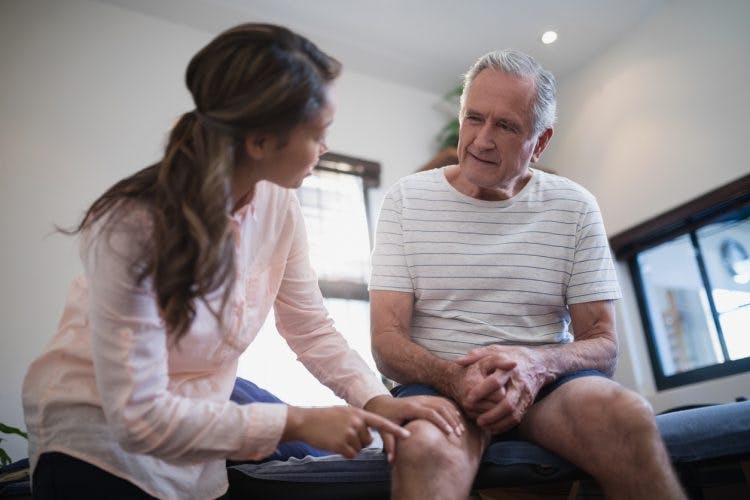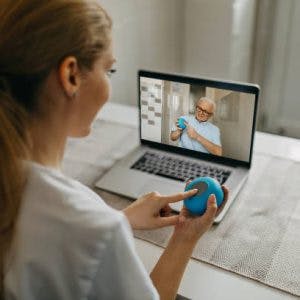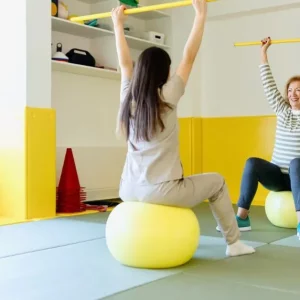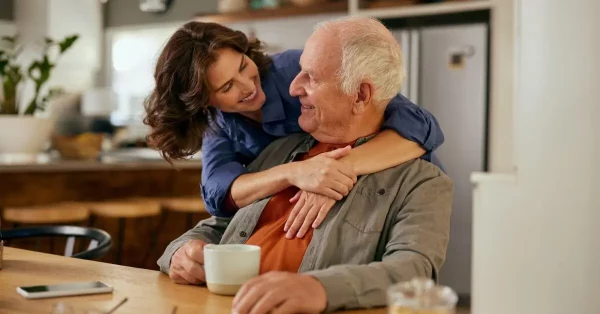Many survivors of stroke experience difficulty with walking, standing, and other functional activities. For example, one study found that 46% of survivors were unable to walk after their first stroke. Thankfully, there is hope for regaining the ability to walk by strengthening the legs through lower limb stroke rehabilitation.
No single strategy will suffice to promote proper gait (walking) recovery. Rather, the most effective treatment uses a combination of approaches.
In this article, we will discuss the best ways to promote lower limb stroke rehab through therapy exercises and other interventions. Some of the interventions we will cover are ones you can do at home, while others will require the help of a therapist or caregiver.
Optimal Lower Limb Stroke Rehabilitation Methods
Therapists will often use several types of physical therapy interventions to help survivors regain the ability to walk. The most common lower limb stroke rehabilitation techniques are often grouped into two main categories:
- Passive neurophysiological techniques
- Active motor learning techniques
Below we will explain both techniques in more detail and how they can work together to promote motor learning and recovery. When learning about these techniques, keep in mind that two of the most important factors in stroke recovery are high repetition of stroke exercises and consistency with your rehab program.
Passive Neurophysiological Techniques
With passive neurophysiological techniques, therapists help patients improve their leg strength by supporting correct movement patterns. In this context, the word “passive” refers to an exercise or intervention that is performed with assistance, or without active muscle use.
In other words, the therapist moves your legs for you to help your brain re-establish its connection to your muscles. They do this by engaging the brain’s natural neuroplasticity, which helps rewire neural connections that were affected by the stroke.
Depending on the areas of the brain affected by stroke, survivors may experience secondary effects such as flaccidity. This lack of active muscle control makes it difficult to perform exercises needed to regain movement in your legs. Fortunately, having someone else assist you with the movement still activates neuroplasticity!
Examples of passive neurophysiological techniques for lower limb stroke rehab may include passive range of motion as well as electrical stimulation. Range of motion, sometimes performed in diagonal patterns, can help facilitate relearning important motor pathways. Passive range of motion can also help maintain flexibility, decreasing the risk of joint contractures after stroke.
Additionally, electrical stimulation after stroke can be a valuable tool for providing input to the brain and encouraging muscle activation. Electrical stimulation can be performed in conjunction with passive and active exercise to maximize benefits and improve performance of functional tasks.
During lower limb stroke rehab, therapists may also have you use specialized equipment like an assistive treadmill. This treadmill involves a harness that supports your body weight and holds you in a standing position. Then, your therapy team can help you move your affected leg and foot in a walking motion as the treadmill moves. This places emphasis on retraining the appropriate muscles to activate during each portion of gait.
An assistive treadmill isn’t just limited to passive movement, however. As you begin to regain some strength and movement in your lower limb, your therapists will encourage you to increase active participation. This means they will have you try to activate as much active muscle movement as possible during each step you take, and they will assist you with completing the full range of the step.
In the video below, you can see an example of an assistive treadmill in action:
Even though the patient is not moving her legs on her own, the passive movement itself will help rewire her brain until she regains more control of her lower limbs.
Active Motor Learning Techniques
As a survivor progresses throughout their recovery journey, they may be able to progress from passive lower limb stroke rehabilitation to active motor learning techniques. These techniques incorporate more active patient involvement, which means you will be doing most of the movements on your own.
One example of motor learning techniques is task-specific training. The basic philosophy behind task specificity is that stroke rehab should target goals that are relevant to the patient. The best way to do this is to practice those goals directly! Finding goals that are important to you will help you stay motivated and consistent with your lower limb rehabilitation after stroke.
For example, you might have a habit of taking daily walks and want to return to this activity. The best way to learn a skill like walking is to practice the movements needed to walk. If you can’t do it all at once yet, then you can break it down into smaller skills and practice those.
In the next section, we will look at some specific techniques you can use to increase your strength and work toward reaching your own unique goals.
Active Techniques for Lower Limb Stroke Rehabilitation
Now that you know a little more about the basic types of lower limb stroke rehab, we would like to review some exercises that can help you regain control of your legs. Your rehab team can also point you in the right direction and can help you create a personalized home exercise program for you to practice.
To get the most out of these exercises, make sure to practice them every day. The more you can stimulate your muscles through high repetition, the stronger the neural pathways your brain creates will become. This will, in turn, give you more control over your leg muscles. Below we have linked our best exercises to use for lower limb stroke rehabilitation to help you get started!
1. Gait Training Exercises for Stroke Patients
Strengthening exercises are crucial for improving your walking and balance skills. This includes strengthening the legs and core, as well as practicing exercises that challenge your balance and coordination.
Although the link above provides a more comprehensive list of gait training exercises, the following are a few exercises you can try at home:
- Seated marching. Start in a seated position. Try to lift your affected leg up towards your chest, using your hand to assist as necessary. Hold a second or two, then slowly lower your leg down to the floor. Repeat on the other leg, alternating for 20 to 30 repetitions.
- Knee extension. Sit on a stool or chair. Next, extend (straighten) your knee as far out as you can. Then slowly allow your knee to bend, bringing your foot back to the floor. Repeat on the other leg.
- Heel rasises. Start in a seated position with your feet flat on the floor. Slowly raise your heels, keeping your toes on the floor. Then lower your heels back down slowly. To increase resistance, try using your arms to press your knees down slightly, as if you are resisting the motion. Or you can perform this exercise in standing while holding a tall counter or railing.
Click here for more examples of leg exercises to do at home »
2. Foot Drop Exercises
Foot drop is a common result of stroke that impairs dorsiflexion, which is your ability to lift the front part of your foot (bringing your toes towards your shin). As a result, a survivor may notice their foot “flopping” on the ground while walking or frequently tripping on the floor or a rug. This can make activities like walking difficult and dangerous, increasing fall risk after stroke.
Therefore, a large part of lower limb stroke rehabilitation will involve retraining the brain to control dorsiflexion as well as strengthening the muscles themselves. You can do this through foot drop exercises such as the ones linked above.
Some of these foot drop exercises include:
- Passive ankle dorsiflexion. Sit in a comfortable position and cross one leg over the other. Then, use your hand to move your toes up towards your shin and back down. Repeat ten times, then switch to your other foot.
- Assisted toe raises. If you can only move one foot, this exercise can help you strengthen your affected foot and ankle. In sitting, place your strong foot underneath your affected one. Then, use your good foot to lift your weak foot into dorsiflexion. Make sure you keep your heel on the ground at all times. Finally, lower the foot back down and repeat at least ten times.
- Ankle eversion. Place your affected foot on the ground. Next, try lifting the outer edge of your foot and toes up so that the inner portion of your foot is bending inwards. Focus on initiating the movement from your ankle without moving your leg. Repeat at least ten times.
In addition to these lower limb stroke rehabilitation exercises, electrical stimulation for foot drop can be a helpful tool to allow survivors to better strengthen and control their foot and ankle. Additionally, some survivors may require an AFO brace for foot drop to increase safety when walking. Ask your doctor or rehab team if these interventions might be appropriate for you.
For more examples of foot drop exercises, check out this video:
3. Home Therapy Devices
Finally, to maximize recovery after stroke and regain lower limb function you will need to complete a high number of repetitions when performing your rehab program. For example, animal studies have shown that it takes about 400 to 600 repetitions per day of challenging functional tasks to cause changes in the brain.
This can be hard to do on your own, however, and many stroke survivors struggle to reach the number of repetitions necessary to make progress. Most people only perform about 40 repetitions of a task during a traditional PT session, which is just 10% of the required amount.
Rehab devices such as Flint Rehab’s FitMi home therapy can help you overcome this problem. FitMi brings an element of gaming to rehab and challenges you to beat your high score. In fact, the average patient accomplishes about 23 times more repetitions with FitMi than with traditional therapy.
The more exercises you perform, the faster you may notice improvements in strength and overall leg function. That’s why exercise devices like FitMi are so helpful for lower limb stroke rehabilitation.
Try FitMi for 30 days risk-free!
Lower Limb Rehabilitation After Stroke
Lower limb stroke rehab often includes a combination of different therapy techniques, depending on the survivor’s specific goals. Since every stroke is different, some survivors may need to start with passive techniques such as assistive treadmills, while others might jump straight to active rehab exercises.
Your rehab team can help point you in the right direction and create a plan that is personalized for you. In addition to passive and active exercise, this program may include techniques such as electrical stimulation or an AFO brace.
Wherever you are in your journey, the only way to improve your lower limb function is to persevere. Even if you can only move your foot a little, keep working hard to activate your muscles and challenge yourself daily. With time and practice, the link between your brain and muscles will become stronger and you’ll find it easier to perform the activities you love.















